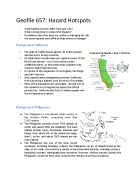Private insurance for landslide hazards is not easily available due to the high risks involved for the insurance companies. Legal liability is becoming an increasingly common loss-sharing adjustment. Since the landslide producing processes are well understood the “acts of god” argument when landslides occur is losing credibility.
Methods of stabilizing hill slopes
Managing snow avalanches
Avalanche formation and their characteristics
An avalanche is a rapid movement of snow down a slope as a result of structural weakness in the snow cover on the slope. There are 3 main forms of snow avalanche with different characteristics of slope failure, flow and occurrence – loose snow, slab and slush.
Slab avalanches are the most dangerous since large masses of snow are involved. Snow builds up in layers following each snowfall event. Initially the density is low, but as snow continues to be added the density in the lower layers increases as air is squeezed out to form firn. However, in some snow packs the snow becomes less dense in places as ice and snow crystal grow and the voids between them are enlarged. This forms a weak layer in the snow called a depth hoar. Thawing and freezing between different snowfalls produces boundaries which act as weaknesses within the snow pack. Avalanches mainly occur on slopes of 25 – 40*. On lower slope angles the shear stresses are insufficient to encourage the snow to fail and on steeper slopes, especially above 60*. Avalanches tend to recur at the same sites and can be detected by breaks of slope, eroded sections, damaged vegetation of different ages, and debris mounds in the run out zone.
Why are avalanches hazards?
In areas of human activity they represent a major hazard, as settlement expands into mountainous regions and tourist development increases, people are becoming increasingly vulnerable. Infrastructures are also at risk. Death and injury from avalanches are the result of impacts, which fracture limbs, suffocation as a result of the pressure of snow. Buildings and structures are at risk from impact pressures of up to 100 tonnes/m2, which can move reinforced concrete structures. The areas of highest hazard exist where there is human settlement and tourist development such as the Alps.
What techniques are used for modifying the hazard event?
Avalanches can be managed through artificial avalanche creation. By creating a series of smaller avalanches at safe times, the hazard can be controlled as the snow pack is removed. This approach is expensive and uses explosives and military weapons.
Modifying the vulnerability
Warning systems are common for avalanche hazards and nearly 30 countries have systems in operation, which use both forecasts and prediction. Forecasts are used for day-to-day management of winter sports area, whereas predictions are used for hazard land zoning. Forecasting is not precise but involves regular snow stability tests and meteorological data. Avalanches triggers by storms are the easiest to forecast but snow pack changes are more difficult. In Switzerland avalanche hazard maps have existed since 1878.
Three zones are used: high potential hazard, moderate, and no hazard. These are based on topographic maps, field observation, long term records, and run out distance. This approach needs much financial and time investment.







